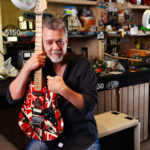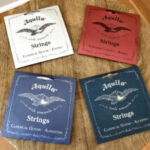Many guitarists exploring layered recordings often worry about phase cancellation when Doubling Guitar tracks. However, phase cancellation is not the primary concern in this scenario. When you record separate guitar tracks, each with its own microphone or DI, phase cancellation, as typically understood with multiple mics on a single source, is not the issue. The real challenge lies in masking, a phenomenon that can muddy your mix and reduce clarity.
Understanding Masking vs. Phase Cancellation
Phase cancellation occurs when the same sound source reaches two microphones at slightly different times. This timing difference causes the waveforms to be out of sync, leading to a reduction or cancellation of certain frequencies. This is common when using multiple microphones on a single guitar amplifier, for example.
However, when you’re doubling guitar tracks – recording the same or similar parts on separate tracks – each recording is independent. Phase issues between simultaneously captured signals are not at play here. Instead, masking becomes the dominant factor. Masking happens when two or more instruments occupy the same frequency range, causing them to compete and obscure each other. Instead of a rich, full sound, you can end up with a muddy, undefined sonic mess, and a constant battle for volume in your mix. While the subtle timing differences between human performances in doubled tracks can add character, overlapping frequencies will fight for sonic space if not managed properly.
Techniques for Effective Guitar Doubling
To achieve a powerful and clear doubled guitar sound, focus on creating separation between the tracks. Here are several effective techniques:
1. Chord Inversions for Harmonic Richness
Instead of simply doubling the exact same chord voicings, utilize different chord inversions. For example, if your first guitar track plays an open E major chord, try using barre chords in different positions for the doubled part. A C barre chord on the 8th fret, an A barre chord on the 5th fret, or a G barre chord on the 3rd fret will create a fuller, richer sound by spreading out the frequencies and adding harmonic complexity. These varied voicings interlock to create a much larger overall sound than simply stacking identical chords. Don’t hesitate to use a capo to explore different inversions and find voicings that complement each other effectively.
2. Timing Variations with Strumming Patterns
Introduce subtle timing variations in your strumming patterns between the doubled tracks. If the first track uses a combination of up and downstrokes for a chord progression, try dedicating one doubled track to only downstrokes and the other to only upstrokes. This rhythmic separation can significantly enhance clarity and definition, especially when panned in stereo. This technique allows the individual tracks to be heard distinctly while contributing to a cohesive overall rhythm. Experiment with different strumming patterns to find what creates the desired sense of width and texture.
3. EQ and Tonal Differentiation
Give each doubled guitar track its own distinct sonic character by using different pickups and EQ settings. If one track is recorded using the bridge pickup for a brighter tone, use the neck pickup on the second track for a warmer, rounder sound. Further refine this separation with EQ. If one guitar track has emphasized midrange frequencies around 4kHz, consider slightly scooping the mids or boosting a different frequency range, like 3kHz or 5kHz, on the doubled track. This carves out sonic space for each guitar, preventing frequency masking and allowing both to shine through in the mix.
4. Gain Staging and Drive Control
Less drive is often more when layering guitars. While a single guitar with heavy distortion can sound powerful, multiple heavily distorted guitars can quickly become a muddy, overwhelming mess. Overdrive and distortion compress the signal and introduce numerous harmonics, which can clash when layered. Try dialing back the gain on your amp or distortion pedals when recording doubled parts. Even reducing your guitar’s volume knob slightly can make a significant difference in clarity. Aim for a point where the tone retains its character but doesn’t become overly saturated. You might be surprised at how much bigger and clearer your layered guitars sound with a more controlled gain structure.
Consider Your Goals for Layering
Before adding numerous doubled guitar tracks, ask yourself: what is the musical goal? Are you trying to compensate for a weak initial guitar tone, or is there a genuine musical purpose for the layering? Often, in recording, less is more. In many cases, two well-recorded and thoughtfully arranged guitar parts are sufficient to create a full and impactful sound. Excessive layering can introduce unwanted noise and reduce the dynamic range of your music. Silence and space between notes are crucial for creating musical dynamics and emotional impact. Overly dense mixes with constant sound can become fatiguing and lack punch. If your doubled parts are clean and played tightly, they can deliver a powerful, unified impact. However, if the timing is loose or the parts are overly similar, the principle of “less being better” often applies. Focus on strong, well-defined parts rather than relying on sheer quantity.
Conclusion
Doubling guitar tracks can be a powerful technique to create a full and impactful guitar sound in your recordings. By understanding the principles of masking and applying techniques like chord inversions, rhythmic variation, EQ differentiation, and controlled gain, you can avoid muddy mixes and achieve a professional, polished sound. Remember to always consider the musical purpose of layering and strive for clarity and dynamic range in your arrangements.


